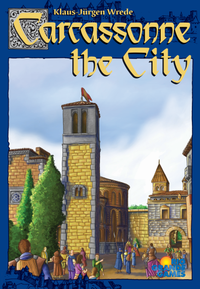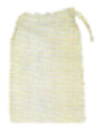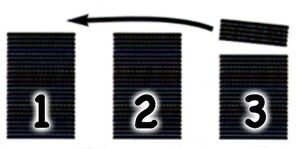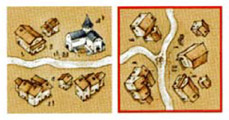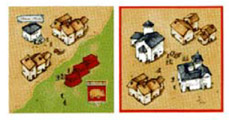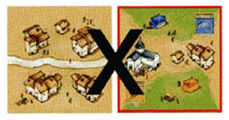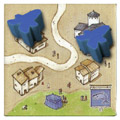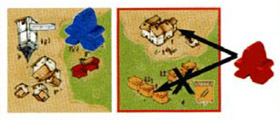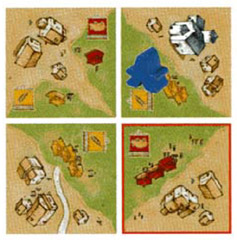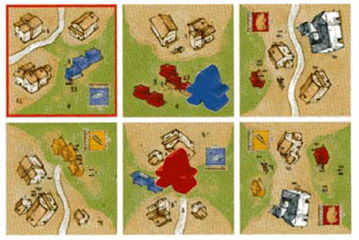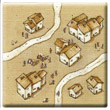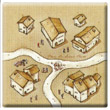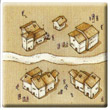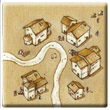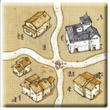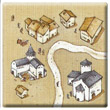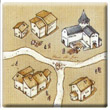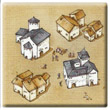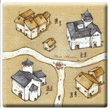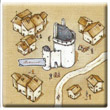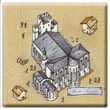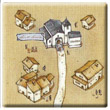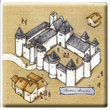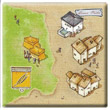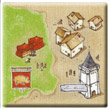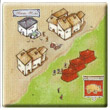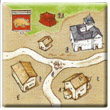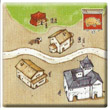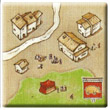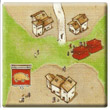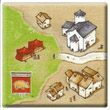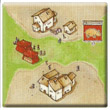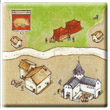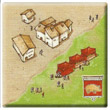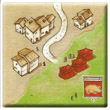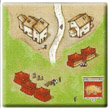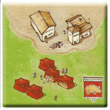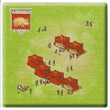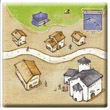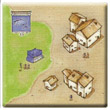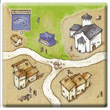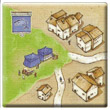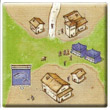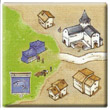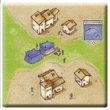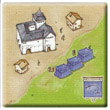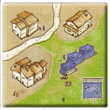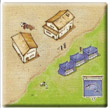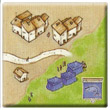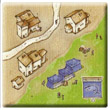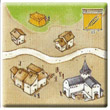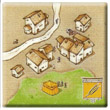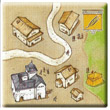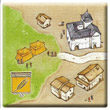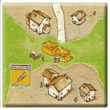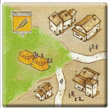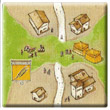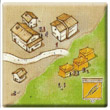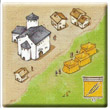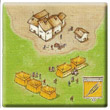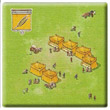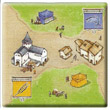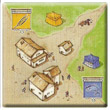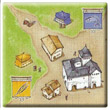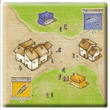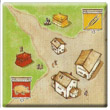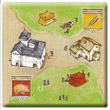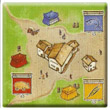The City Base Game
Main Page > The City > The City Base Game
Originally released by Hans im Glück in 2004, Carcassonne: The City is a tile-laying game for 2-4 players, ages 8 and up. It is based on the Carcassonne game system from Klaus Jürgen Wrede, but is not compatible with any of the other games.
The game uses many of the standard Carcassonne game concepts. Players create the old town by laying tiles. As the town grows, the walls are built around it, starting from a single wooden gate. The wall is created from wooden pieces forming a 3d version of the medieval town at the end of the game. Each player also receives several cylindrical wooden towers (how many depends on the number of players), giving the town walls added impact.
"The impressive city of Carcassonne was a magnet for tourists from all lands even in The Middle Ages. Its large markets, grandiose homes and busy streets ade the whole city a popular attraction. Here is your chance to build the city of Carcassonne! Players build walls, build towers, found markets, and place followers in the normal way. At the end, you will all enjoy looking at the beautiful 3-D city you have built!"
Contents
- 70 wall pieces
- 2 short walls
- 1 city gate
- 12 towers
(l-r): standard wall piece, short wall piece, city gate, tower
- 32 followers in 4 colours
- 2 bags to hold the city tiles and wooden pieces
- 1 scoring track
- 75 city tiles which show different street segments, residential areas, markets and buildings
The goal
The players work together to build the city of Carcassonne with residential areas, markets (fish, grain, and livestock), streets and walls.
Through the clever placement of their followers, they score points during and at the end of the game.
Preparation
Each player takes 8 followers in a selected colour, places one on the 0 space of the scoring track, and puts the rest as their supply, on the table in front of them (their play area).
The players divide the 12 towers equally amongst themselves
Shuffle the tiles face down and place in 3 stacks. The first stack should contain 30 tiles, the second stack 25, and the third stack 20. The fastest way to do this is to create three equal stacks (with 25 tiles), and then move 5 tiles from the third stack to the 1st stack. Place the first stack within reach of all the players.
Place the other two stacks, the 70 wall tiles, the 2 short wall tiles, and the city gate aside for now. They will be used later in the game.
The players choose a starting player. That player begins by drawing the top-most tile from the 1st stack and placing it face-up in the middle of the table. The player may place one of their followers on one of the features (street, market, or residential area) of the tile. The rules for placing followers are described later.
Playing the game
The players take turns in clockwise order, following the starting player. A player, on their turn, takes the following actions in the order show:-
- The player must draw a new tile and add it to the city
- the player may place a follower from their supply on the just added tile
- If the just added tile completed a street or a market, the players must now score it
Adding tiles to the city
As their first action, the player must draw the top-most tile from the 1st stack and add it to the city as follows :-
- The player must place the added tile (shown with a red border in all examples) with at least one side directly adjacent to one or more already placed tiles. A player may not place a tile so that the only other tile it touches is at a corner.
- The player must place added tiles such that streets are continued (when present). All other tiles features may be placed next to each other without regard for matching the features.
| Street segments must be continued |
A residential area may be placed next to a market |
This is not allowed as the added tile does not continue the street from the previous tile |
Placing followers
After adding a tile, the player may place one of their followers as follows :-
- The player may only place 1 follower
- the player must take the follower from their supply
- the player may only place the follower on the tile just added
- the player must carefully place the follower on one of the segments on the tile - either as ...
| a Citizen | a Seller | a Steward | ||
| or as | or as | |||
| on a street segment (standing) |
on a market (standing) |
on a residential area (place lying down in either of the shown locations) |
Placement restrictions
If the added tile continues a street, market or residential area from previous tiles with a follower, the player may not place a follower on that feature (even if the other follower is of the same colour). It matters not how far away the other follower is, as long as it is on a continuation of the feature. When a player adds a tile that completes a market or a street that has no previous follower, the player may not place a follower on that feature. The three examples below should help to make these rules clear.
| Red may only place a steward. In the extended market, there is already a blue seller |
Blue may place a follower as a seller or a citizen, or as a steward on the small residential area (red arrow) as there is already a blue steward on the large residential area. |
Blue may not place a follower on the empty market, as it was completed by placing the tile. |
When a player has no more followers in their supply, they continue to play tiles (but no followers). This lack of followers is usually short-lived, as players get followers back when they score them.
If, through the placement of a tile, a street or a market was completed, the players now score the completed feature. Residential areas are not scored at this time.
Now, the player's turn is over and the next player, in clockwise order, takes their turn.
Scoring completed streets and markets
A completed street
A street is complete when the street segments on each end of the street terminate in a crossing, another feature or, later in the game, against a wall. A street is also complete when it forms a closed loop. Between the end points, a street can have any number of street segments, but the player's score is based on the number of tiles in the street.
For a completed street with 1-3 tiles, the player with the citizen on the street scores 1 point for each tile along the length of the street (number of tiles in the street, not number of segments).
For a completed street with 4 or more tiles, the player with the citizen on the street scores double the points described above (number of tiles x 2).
Players immediately record their points by moving their followers on the scoring track a number of spaces forwards equal to the amount scored. When a player's marker passes 0 (50 points) the follower should be placed on its side to indicate it has scored 50+ points.
A completed market
A market is complete when it cannot be further continued (it is bordered on all sides) and has no empty spaces within it. A market can have any number of tiles.
For a completed market, the player with the seller on the market scores points equal to the number of tiles in the market multiplied by the number of different kinds of market (fish, grain, livestock). Only the first occurrence of a kind of market counts towards the score of the multiplier. Multiple occurrences of the same kind of market add nothing to the score of the market.
What happens when several followers stand on a completed street or market?
Through clever tile and follower placement, it is possible for a completed street or market to have several followers. This happens when separate features are connected. In this case, the player with the most followers on the feature scores all the points. When players tie with the most followers on a feature, each scores the full points. Players not tied for the most, score nothing.
The remaining rules and images will follow shortly
Special rules for 2 players
With 2 players the number of walls built is doubled.
- After scoring during the 2nd stack each player builds 2 walls
- After scoring when using the third stack, each player builds 4 walls
The players take turns building 1 wall each until they have built 2 or 4 walls.
In the very first wall building round with the 2nd stack, the player whose tile placement caused the scoring builds the city gate first, then the other player builds 1 wall, then the tile placing player builds 1 wall and, finally, the other player builds 1 wall.
Tile Distribution
Total Regular Tiles: 75
Footnotes
For Icons explanation and licensing please visit Icons page.
